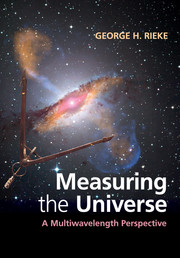Book contents
- Frontmatter
- Contents
- Preface
- 1 Radiometry, optics, statistics
- 2 Telescopes
- 3 Detectors for the ultraviolet through the infrared
- 4 Optical and infrared imaging; astrometry
- 5 Photometry and polarimetry
- 6 Spectroscopy
- 7 Adaptive optics and high-contrast imaging
- 8 Submillimeter and radio astronomy
- 9 Interferometry and aperture synthesis
- 10 X- and gamma-ray astronomy
- 11 Epilogue: cosmic rays, neutrinos, gravitational waves
- Appendix A Useful constants
- Appendix B Common Fourier transforms and relations
- References
- Index
- References
8 - Submillimeter and radio astronomy
Published online by Cambridge University Press: 05 November 2012
- Frontmatter
- Contents
- Preface
- 1 Radiometry, optics, statistics
- 2 Telescopes
- 3 Detectors for the ultraviolet through the infrared
- 4 Optical and infrared imaging; astrometry
- 5 Photometry and polarimetry
- 6 Spectroscopy
- 7 Adaptive optics and high-contrast imaging
- 8 Submillimeter and radio astronomy
- 9 Interferometry and aperture synthesis
- 10 X- and gamma-ray astronomy
- 11 Epilogue: cosmic rays, neutrinos, gravitational waves
- Appendix A Useful constants
- Appendix B Common Fourier transforms and relations
- References
- Index
- References
Summary
Introduction
The submillimeter and millimeter-wave regime – roughly λ = 0.2 mm to 3 mm – represents a transition between infrared and radio (λ > 3 mm) methods. Because of the infinitesimal energy associated with a photon, photodetectors are no longer effective and we must turn to the alternative two types described in Section 1.4.2. Thermal detectors – bolometers – are useful at low spectral resolution. For high-resolution spectroscopy (and interferometers), coherent detectors are used. Coherent detectors – heterodyne receivers – dominate the radio regime for both low and high spectral resolution (Wilson et al. 2009).
As the wavelengths get longer, the requirements for optics also change. The designs of the components surrounding bolometers and submm- and mm-wave mixers must take account of the wave nature of the energy to optimize the absorption efficiency. “Pseudo-optics” are employed, combining standard lenses and mirrors with components that concentrate energy without necessarily bringing it to a traditional focus. In the radio region, non-optical techniques are used to transport and concentrate the photon stream energy. For example, energy can be conveyed long distances in waveguides, hollow conductors designed to carry signals through resonant reflection from their walls. At higher frequencies, strip lines or microstrips can be designed to have some of the characteristics of waveguides; they consist of circuit traces on insulators and between or over ground planes.
- Type
- Chapter
- Information
- Measuring the UniverseA Multiwavelength Perspective, pp. 230 - 265Publisher: Cambridge University PressPrint publication year: 2012



